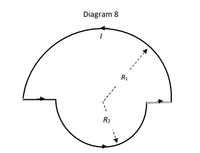
College Physics
11th Edition
ISBN: 9781305952300
Author: Raymond A. Serway, Chris Vuille
Publisher: Cengage Learning
expand_more
expand_more
format_list_bulleted
Question
Question in the attachments

Transcribed Image Text:**Diagram 8 Explanation**
This diagram visually represents a semi-circular loop with an additional semicircle beneath it, indicating a magnetic or electric circuit. Here are the key elements of the diagram:
- **Arc and Arrows**: The main arc at the top is a semicircle with directional arrows representing current flow, labeled as \( I \). The arrows are uniformly oriented, suggesting the direction of flow within the loop.
- **Radial Lines**: Dashed radial lines labeled \( R_1 \) and \( R_2 \) are projected from the center of the arcs to their respective curved lines. These likely represent radii or distances from the center point to specific areas on each semicircle, potentially demonstrating aspects related to magnetic or electric fields or distances critical for calculations in electromagnetism.
- **Directionality**: The directional arrows along the perimeter of both semicircles could denote the path of current or indicate the lines of magnetic force, depending on the specific application or context of the diagram.
This diagram could be used for educational purposes in physics, specifically when covering topics such as electromagnetism, magnetic fields, or circuit analysis, highlighting concepts like current flow, magnetic field direction, or circuit configuration.

Transcribed Image Text:This problem refers to diagram 8.
A wire is bent so there are two semicircles, one of radius 0.189 mm and the other of radius 0.732 mm. If the wire carries a current of 728 A, find the magnitude of the magnetic field, in T, created by this current at the common center of the semicircles.
Expert Solution
arrow_forward
Step 1
Magnetic field around a circular wire is given by
In given figure there are two semicircles having radius whose values are :
Magnetic field due to semicircle is half of magnetic field due to circular wire
Step by stepSolved in 2 steps

Knowledge Booster
Learn more about
Need a deep-dive on the concept behind this application? Look no further. Learn more about this topic, physics and related others by exploring similar questions and additional content below.Similar questions
- During inspiration, the volume of the lungs is actively increased by the action of the diaphragm. As the volume of the lungs increases, the pressure within the lungs falls about 1 mmHg below atmospheric pressure. Air rushes into the lungs due to this pressure difference. Bronchi, Bronchial Tree, and Lungs Larynx Primary bronchi Secondary bronchi Tertiary bronchi. Bronchioles Cardiac notch Pulmonary vein Pulmonary artery Trachea Alveolar duct Alveoli This image is part of the Public Domain: https://upload.wikimedia.org/wikipedia/commons/d/db/Illu_bronchi_lungs.jpg Fig. 1: The bronchi, bronchial trees, and the lungs. (a) The diameter of the trachea (windpipe) is about 17 mm. What net force does the air experience during inhalation? Fne = net N L (b) The flow rate of air entering the lungs is about 1.1 What is the velocity of air moving S through the windpipe? V windpipe = cm Sarrow_forwardAttach Is the questionarrow_forwardSee attached.arrow_forward
arrow_back_ios
arrow_forward_ios
Recommended textbooks for you
 College PhysicsPhysicsISBN:9781305952300Author:Raymond A. Serway, Chris VuillePublisher:Cengage Learning
College PhysicsPhysicsISBN:9781305952300Author:Raymond A. Serway, Chris VuillePublisher:Cengage Learning University Physics (14th Edition)PhysicsISBN:9780133969290Author:Hugh D. Young, Roger A. FreedmanPublisher:PEARSON
University Physics (14th Edition)PhysicsISBN:9780133969290Author:Hugh D. Young, Roger A. FreedmanPublisher:PEARSON Introduction To Quantum MechanicsPhysicsISBN:9781107189638Author:Griffiths, David J., Schroeter, Darrell F.Publisher:Cambridge University Press
Introduction To Quantum MechanicsPhysicsISBN:9781107189638Author:Griffiths, David J., Schroeter, Darrell F.Publisher:Cambridge University Press Physics for Scientists and EngineersPhysicsISBN:9781337553278Author:Raymond A. Serway, John W. JewettPublisher:Cengage Learning
Physics for Scientists and EngineersPhysicsISBN:9781337553278Author:Raymond A. Serway, John W. JewettPublisher:Cengage Learning Lecture- Tutorials for Introductory AstronomyPhysicsISBN:9780321820464Author:Edward E. Prather, Tim P. Slater, Jeff P. Adams, Gina BrissendenPublisher:Addison-Wesley
Lecture- Tutorials for Introductory AstronomyPhysicsISBN:9780321820464Author:Edward E. Prather, Tim P. Slater, Jeff P. Adams, Gina BrissendenPublisher:Addison-Wesley College Physics: A Strategic Approach (4th Editio...PhysicsISBN:9780134609034Author:Randall D. Knight (Professor Emeritus), Brian Jones, Stuart FieldPublisher:PEARSON
College Physics: A Strategic Approach (4th Editio...PhysicsISBN:9780134609034Author:Randall D. Knight (Professor Emeritus), Brian Jones, Stuart FieldPublisher:PEARSON

College Physics
Physics
ISBN:9781305952300
Author:Raymond A. Serway, Chris Vuille
Publisher:Cengage Learning

University Physics (14th Edition)
Physics
ISBN:9780133969290
Author:Hugh D. Young, Roger A. Freedman
Publisher:PEARSON

Introduction To Quantum Mechanics
Physics
ISBN:9781107189638
Author:Griffiths, David J., Schroeter, Darrell F.
Publisher:Cambridge University Press

Physics for Scientists and Engineers
Physics
ISBN:9781337553278
Author:Raymond A. Serway, John W. Jewett
Publisher:Cengage Learning

Lecture- Tutorials for Introductory Astronomy
Physics
ISBN:9780321820464
Author:Edward E. Prather, Tim P. Slater, Jeff P. Adams, Gina Brissenden
Publisher:Addison-Wesley

College Physics: A Strategic Approach (4th Editio...
Physics
ISBN:9780134609034
Author:Randall D. Knight (Professor Emeritus), Brian Jones, Stuart Field
Publisher:PEARSON